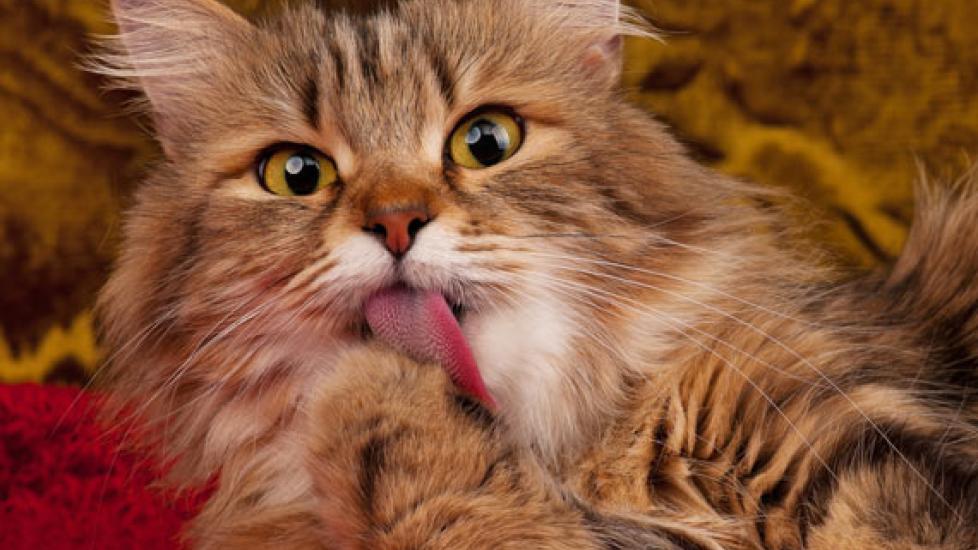Best Cat Food and Treats for Hairballs
Reviewed and updated for accuracy on April 14, 2020 by Dr. Jennifer Coates, DVM
Live with cats for long enough, and you’re bound to find a hairball on the floor (or in your bed or shoe—if you’re really unlucky). But hairballs don’t have to be a regular part of cat ownership.
Cats bring up hairballs frequently enough that it’s easy to think of them as being normal, but, in fact, they are a symptom of a problem. You can think of hairballs in the same way that you might view diarrhea—both happen from time to time, but they are still symptoms of a health issue.
The most common issues behind hairballs are gastrointestinal dysfunction or skin diseases that cause excessive self-grooming and/or hair loss.
Here’s what you need to know about when hairballs are a bigger issue and how you can help manage hairballs through your cat’s diet.
Go to the Vet If You See Frequent Hairballs
If you’re finding hairballs more frequently than once a month or so, it’s time to make an appointment with your veterinarian to look for an underlying problem.
A complete work-up for chronic or severe hairballs starts with a patient history and physical exam and may include:
-
Skin scrapings to look for mites
-
Tests for ringworm
-
Cytology to rule out skin infections
-
Abdominal imaging
-
Blood work
-
Urinalysis
-
Fecal examinations
-
Possibly, biopsies of the gastrointestinal tract or skin
What to Feed Your Cat to Treat Occasional Hairballs
If your cat only has occasional hairballs and is otherwise healthy, dietary management is your best option.
Hypoallergenic Diets
Undiagnosed food allergies or inflammatory bowel disease often play a role in the formation of hairballs.
These conditions cause the gastrointestinal tract to become inflamed, and that inflammation interferes with a cat’s natural ability to deal with hair that is swallowed (in other words, keep it moving in the right direction).
Hypoallergenic diets can help in this case.
How to Find the Right Hypoallergenic Cat Food
Diets that are somewhat hypoallergenic are available over the counter through many pet food retailers. Look for products that contain only one major protein source that your cat has never eaten before.
These diets are often advertised as being “limited ingredient,” but read the label closely to determine what is actually included.
Feed the Hypoallergenic Diet Exclusively for 8 Weeks
You will need to feed one of these foods (and nothing else!) for about 8 weeks before you can say definitively whether or not it is helping.
If you’ve tried a couple over-the-counter, limited-ingredient foods with little success, talk to your veterinarian about prescription diets. These are prescribed by veterinarians and tend to be significantly less allergenic.
Recommended Pet Products
- Nutramax Proviable Probiotics & Prebiotics Digestive Health Supplement for Dogs & Cats, 160 count$89.98Chewy Price
- Fera Pets USDA Organic Pumpkin Plus Fiber Support for Dogs & Cats, 90 servings$34.95Chewy Price
- All Four Paws Comfy Cone E-Collar for Dogs & Cats, Black, Small$20.24Chewy Price
- Virbac Epi-Otic Advanced Ear Cleaner for Dogs & Cats, 4-fl oz bottle$12.34Chewy Price
High-Fiber Cat Food for Hairball Control
A high-fiber diet will also help some cats with hairballs.
Different types of fiber perform different digestive roles. Insoluble (indigestible) fiber sources like cellulose, hemicelluloses, and lignins can help sweep hair through the intestinal tract.
Sources of soluble (partially digestible) fiber, including chicory, inulin, fructooligosacharides, pectins, psyllium, plant gums, oats, barley, beet pulp, and some types of fruits and legumes, perform a similar function and also promote overall gut health.
The bacteria that live in a cat’s large intestine partially break down soluble fibers, producing short-chain fatty acids that are important energy sources for the cells that line the large intestine.
How to Pick Out a High-Fiber Cat Food
Several pet food manufacturers have added fiber to their formulations to create “hairball” diets that work well for some cats.
Look for dry diets with a crude fiber percentage of around 8-10% and canned options in the 2-4% range, but keep in mind that crude fiber does not account for insoluble fiber sources.
If you are looking for a way to add fiber to your cat’s current food, try mixing in a little canned pumpkin or unflavored psyllium.
Hairball-Control Treats
The great majority (90% or more) of your cat’s diet should be made up of nutritionally complete and balanced foods. The remaining 10% of calories can be provided by treats.
If your cat has a mild hairball problem, a hairball treat that boosts their soluble and/or insoluble fiber intake might help. Or for greater effect, try combining hairball treats with a hairball diet.
Hairball-Control Gels
Lubricant gels that contain petroleum jelly, waxes, or oils are also options for hairball control. They coat hair in the GI tract and prevent it from forming clumps.
Cats should not be forced to eat a hairball lubricant because the stress and mess outweighs any potential benefit, but you can try adding it to your cat’s food or putting a little on your cat’s paw for them to lick off.
Do not give your cat a flavored hairball lubricant if you are also feeding a limited ingredient diet.
Brushing Your Cat Can Also Help to Reduce Hairballs
And don’t forget this simple, non-dietary hairball remedy: brush your cat (assuming it’s a pleasant experience for the two of you).
Any hair that you can toss in the garbage is hair that won’t be swallowed and redeposited on your floor in the form of a hairball.

Dr. Jennifer Coates
Image: Lubava / Shutterstock




